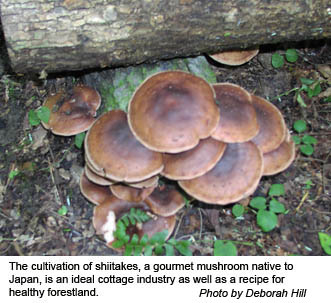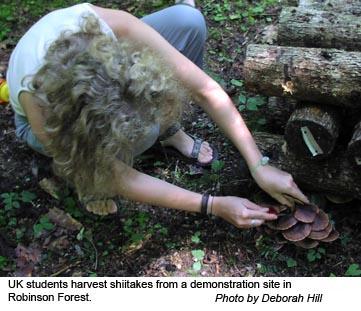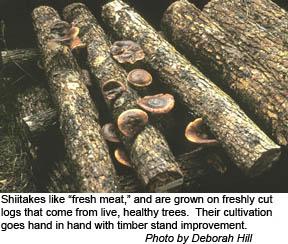Forest Crop Mushrooming for Small Holdings
Forest Crop Mushrooming for Small Holdings

It’s exotic in origin but becoming more and more popular domestically. Some might consider its looks to be lackluster, except when perfect conditions produce eye-catching sunburst patterns. It’s full-bodied, meaty, with a garlicky taste. And it lives for only one thing in life – to devour wood.
It’s a shiitake and it’s a mushroom with attitude, according to University of Kentucky Forestry professor Deborah Hill, who promotes the growth of the gourmet mushroom as both an ideal cottage industry and a recipe for healthy forestland.
Most shiitake growers in the state are doing it for “recreational use,” Hill said, which means they’ve put just a few logs into production, providing mushrooms for their own use. There are also a handful of people growing shiitakes on thousands of logs and selling on a regular basis. Hill, who conducts workshops around the state in late winter and early spring, wants to get enough commercial production going in the state to make the mushroom a commodity.
“What I’m interested in is lots and lots of people who might be interested in doing 500 to 1,000 logs, which sounds like an awful lot, but it isn’t,” she said. Considering the amount of money it requires for start up (approximately $2.50 to $3.00 per log) and the fact that it requires less labor than growing grains or vegetables, it’s not a bad return on an investment, Hill said. She consistently gets $8 a pound for them. Some people sell them for $8 a pound, but ask $5 for a half pound and $3 for a quarter pound. Because most people want to buy a quarter pound, the grower is actually making closer to $12 a pound with that type of pricing.
Shiitake production has some appealing aspects to it, according to Hill. As a supplemental income, there is less day-to-day labor, relative to other crops.  “Maintain the moisture. Keep the critters off as much as possible. Keep the logs relatively clean and keep them off the ground,” she said.
“Maintain the moisture. Keep the critters off as much as possible. Keep the logs relatively clean and keep them off the ground,” she said.
There is some start-up time to take into consideration. Because the logs must be freshly cut from healthy trees, they must be acquired at the appropriate time of year. That means cutting the trees in late winter or early spring when the sap is rising and they are coming out of dormancy. The logs should be inoculated with spawn, containing mushroom spore, within two weeks of being cut. Spawn also must be ordered from suppliers, so ordering and delivery must be figured into the timeline. Then it can take anywhere from six to 18 months for the first mushrooms to appear. After the first flush of mushrooms appear, the logs can be put into a nine-week production cycle.
The growing market for the mushroom can be an enticement to potential growers. Since the shiitake was introduced to the United States from Japan in the 1970s, the market has increased steadily, as consumers became more interested in supporting local farmers and in trying healthy alternatives in the kitchen.
“On a cottage industry basis, I think it can be very effective,” Hill said. “Now we’ve got farmers’ markets everywhere. Talk about mushrooming, these things have grown like crazy over the past five years …. Any place that does natural food and has produce would probably be willing to buy shiitake mushrooms. A surprising range of restaurants will buy them.” Hill also said that the crop is a good addition to a farm sustained by Community Supported Agriculture. With a CSA enterprise, the farmer sells shares of the farm to consumers, who then receive a proportionate amount of produce every week. Adding an exotic crop, such as shiitake mushrooms, to a CSA enterprise means a farmer could increase the price of a share, while not adding disproportionately to the labor.
Hill also said that the crop is a good addition to a farm sustained by Community Supported Agriculture. With a CSA enterprise, the farmer sells shares of the farm to consumers, who then receive a proportionate amount of produce every week. Adding an exotic crop, such as shiitake mushrooms, to a CSA enterprise means a farmer could increase the price of a share, while not adding disproportionately to the labor.
“That makes all the sense in the world,” she said. “And it’s a whole different marketing thing than trying to deal with supermarkets or restaurants or even the farmers’ market.”
Hill advises interested growers that marketing will be a big part of their success.
“You have to establish your own markets. They (shiitakes) are marketable, but it’s not soybeans. It’s not corn. It’s not tobacco. You can’t just plug it in and somebody else is going to take care of it,” she said. “The producer has to be the responsible party for finding a market and taking care of the market.”
Because shiitake mushrooms thrive on healthy wood from freshly cut live trees, or “fresh meat,” as Hill says, their production goes hand in hand with timber stand improvement.
“As a forester, I was looking at small woodlot management, and, I thought, we have so many small ownerships in this state,” she said, adding, “You can’t do timber production on 10 acres of forest. But you can do other things, shiitake being one of them.”
Hill explained that timber stand improvement is basically another term for weeding, taking out undesirable species or smaller trees that might be crowding large trees. That type of weeding can produce the fresh-cut logs from healthy trees that the mushrooms require.
“You’re improving the quality and the health of the forest that you have,” she said, “and then, figuring out ways to get income from that, too.”
If you are interested in learning more about growing shiitake mushrooms, contact your local county Extension agent or Deborah Hill at dbhill@uky.edu.
